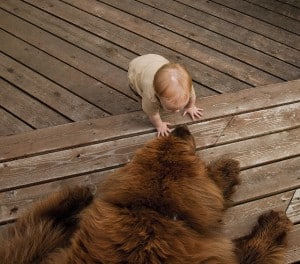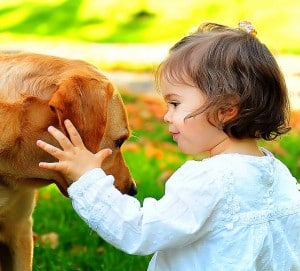9 Ways to Get Your Dog Ready to Meet Your New Baby
Many moons ago, before I racked up three cats to my name, I had another furry addiction—I had a house full of dogs.
I owned a handful of my own and fostered many more for a local rescue group. I could never quite get the stink of dog off my hands no matter how often I washed them, and I sometimes fantasized about inventing a full-body lint-rolling device that would surely make me millions.
As a foster, you come across all different types of dogs – shy or outgoing, dogs who lick your toes or dogs who go for your crotch, sweet lap dogs or dogs like that one named Tigger who had a 5-foot vertical leap and REALLY liked to show it off. So I took training and obedience classes from several different dog trainers to learn how best to manage my ever-changing pack.
One of the most valuable situations I learned to handle was how you properly introduce your dog to a new baby – so your beloved Cosmo doesn’t think Baby is his new chew toy.
You get yourself ready for baby by building a registry for the baby must haves and the just plain awesome and by making a pre-baby checklist – so don’t forget that your pup needs to get ready too.
If you think your dog doesn’t need any help to get ready to meet your new baby, remember this: Dogs can tell you’re pregnant even in the first trimester. They just don’t know how many puppies you’re having.
And as you’ll learn below, their fear of that unknown could lead to serious problems. Children are the most common victims of dog bites, with half of bite victims being under the age of thirteen.
Bonus: As a bonus for joining my weekly newsletter, get a free checklist that will help you get your dog ready to meet your new baby.
First, a Caveat (Or Three)
- If any of these tips don’t make sense, please follow up with a professional trainer. I am nowhere near a professional. I just wanted to share the few tips I’ve learned over the years on how to succeed at introducing dog to baby. It’s better to be safe and understand what you’re doing than to confuse your dog.
- This post is very matter-of-fact about what can go wrong. One trainer always said he was being blunt on purpose because he’s tired of seeing perfectly fine animals having to be put down or dropped off at a shelter because they were set up for failure when the new baby came into the house. The best time to prepare is before a new baby arrives. After, you’ll have much less time for dog training.
- If your dog shows any warning signs with your babe like growling, snapping, or lunging, please seek professional help immediately. If you wait until the warning signs progress to an actual bite, it’s a harder problem to solve.
Now onto the tips…
9 Tips for Introducing Dog to Baby
At the end of this post, you can get a free checklist version of these tips. Don’t just bookmark this page and forget about it until after your baby’s born and your dog is stressing out – print the checklist and stick it on your fridge now!
1. Sit on the Couch
Aggressive dogs typically have two things in common: They’re not good on a leash, and they have a bad recall – i.e. they don’t always come when you call them. So if your dog isn’t great in those two areas, those would be good things to work on to start with. Recall is easy peasy. You don’t even have to get off the couch!
- Get a few treats ready to go in your hand or pocket. (My dogs and fosters always LOVED the Solid Gold Turkey Jerky treats, and they’re soft enough to break in half to make your training treat stash last longer.)
- Sit on a chair or the couch with your legs slightly open – enough room so your dog can come sit between your legs.
- Call your dog: “Tuna, come!”
- Wait til they come and sit at your feet.
- The moment their butt hits the ground, give that pup a treat!
2. Understand Why Your Dog Loves You
Even though we like to think that dogs love us, what they really love are RESOURCES. They love that we provide the resources they want – food, attention, play, and so on. What is typically behind any behavior issue is fear and frustration about resources. For dogs, it’s all about another pack member to feed and share resources with.
3. Play the Bumping Game

Space is the biggest way to control resources in the home. This is BIG for preventing aggression from the time your child can walk until it grows out of toddlerhood. Why? Because controlling the space will teach your dog to move out of the child’s way as it approaches.
Do you step around or over your dog at home? Stop doing that! You’re letting your dog control the space.
Start playing the bumping game:
- If your dog is in your path, stay on your path.
- Don’t make eye contact with the dog.
- Nudge the dog with your foot to get the dog to move out of your way, then continue on your way. A few tips:
- Don’t kick the dog as you push through – that’s not necessary. Just put your foot forward and push through until the dog moves.
- Don’t verbally warn the dog that you’re about to make them move. Just do it. Dogs don’t verbally warn each other when they’re about to walk through each other’s space. And your toddler won’t be able to say “excuse me,” so don’t waste your breath teaching your dog that they need to move out of your way only when you ask politely.
You may feel bad at first, but if you want to prevent your dog from snapping at or biting your toddling babe, it is essential to establish that you control the space and not your dog. From the time your precious bundle learns to walk, he – much like a drunken sailor – stumbles into the sleeping or eating area of the dog. The dog will typically correct to the child’s face. If you’ve ever seen a dog correct another dog, that’s exactly how they do it – over the muzzle. YOU DON’T WANT THIS TO HAPPEN.
After playing the bumping game consistently, what you should start to notice is your dog seeing you coming and getting out of your way. That’s exactly the behavior you want for your child. Score!
4. Switch the Kibble

Photo by Rachel Patterson.
Diet is important for dogs. For the same reason kids will have behavior problems if you feed them a lot of sugar every day, dogs will react to a bad diet too. Avoid these ingredients in your dog’s food: corn, wheat, soy, eggs, dye, sugar. Everything but sugar is a common allergen for dogs, and sugar is bad for behavior in general.
Some brands I’ve had good luck with are California Natural and Wellness. You might have to buy at a pet store or online instead of at the grocery store, but diet makes all the difference in the world for preventing behavior problems. It’s worth it.
Bonus Tip: Bananas produce serotonin, which can help combat aggression. So if you find a kibble with banana as an ingredient, great. Otherwise, you can give your dog a little banana everyday. (Now you have a way to use up all those over-ripe bananas instead of letting them stink up your trash can til garbage day.)
5. Put Your Dog on a Feeding Schedule
Always give your dog its daily kibble AFTER you and your kids eat. This establishes your family as the leaders of the pack.
Also, don’t leave your dog’s kibble out all day long. The dog will be stressed when the food is left out all day because they will see it as a resource to guard. When you feed the dog, you should set the food down, they should eat it, then you should pick up the bowl when they’re done. If the dog leaves the food bowl, they’re done. Pick it up. Don’t worry – they’ll learn fast.
6. Play House

a whole book on the topic.
Before your baby arrives, get a baby doll that matches your skin color (like this). Get blankets, baby powder, toys, diapers – anything you know you’ll be using with the baby.
Starting when you’re about 7 months pregnant, play house for 20 minutes (or more) every night. Nurse the baby doll, play with it, put it in a baby carrier attached to your body – do anything you can think of. All the while, make sure you’re playing the bumping game. The reason you’re doing this is to set the rules now for how to act around the baby because when the baby comes, you’ll be too busy to worry about this.
7. Capture Baby Smells
Get 12 gallon-sized plastic bags and put them in the bag that will go to the hospital or birthing center. Everything that gets changed off the baby like booties, hats, onesies, etc, goes into a bag. Seal the bag right away and don’t open it again til you use it. One item per bag. (And no, don’t put dirty diapers in the bags.)
Then after baby is born but before baby comes home, send your partner home to check on the dog and do as many of these as possible:
- Before you walk in the door, open a bag and attach an item to you somehow – for example, tie a piece to your belt loop. You want to get the smell of the baby on your body so when the dog has the happy emotion of seeing you, they’ll associate the smell of the baby with that.
- Rub an item on a ball, then play fetch. I promise you’re not teaching the dog to fetch the baby. But the dog will associate the smell on the ball with the happy emotion of playing fetch.

- Put an item at the bottom of the dog’s food bowl and put the food on top. Again, you’re not teaching the dog to eat the baby. But smell is the most powerful sense for dogs, so you’re using that to your advantage to associate the baby’s smell with happy times for the dog.
8. Feed Often
When you bring another human home, the dog will think there will be fewer resources for him, so your job is to show the dog that’s not the case.
Feed the dog 10 times a day, with at least two minutes between each feeding. Do this for two weeks. Feed the same amount of kibble you usually do, but just split it up into 10 parts. The dog won’t understand that they’re getting the same amount of food, they’ll just think they hit the jackpot! This will be a good association for them to have with the arrival of the baby. After two weeks, start tapering. Do 8 times for 2-3 days, 6 times for 2-3 days, and so on.
9. Now Teach the Baby

When the baby is about 4 months old, sit her on your lap. Call the dog over and get him to sit at your feet. Pet the dog with long, soft strokes and say “easy.” Never pat the head of the dog. This is how you teach a child to pet a dog and not hit.
Also, don’t allow your baby or toddler to see you turning the dog’s ears to check them. You don’t want to teach the child that it’s okay for her to do that to the dog.
Get Your Free Printable
- Get the checklist. You’ll get the printable, plus join my weekly newsletter! Just click here to get it and subscribe.
- Print.
- Stick it on your fridge, and get to work prepping that pup!
This post is dedicated to Lee Mannix (1969-2010). He knew a whole heck of a lot about dogs.
Before you go, get my FREE cheat sheet: 75 Positive Phrases Every Child Needs to Hear
Want More?
For more tips on getting ready for baby’s arrival, check out:
- Preparing Your Dog for a New Baby
- Tell Your Dog You’re Pregnant: An Essential Guide For Dog Owners Who Are Expecting A Baby (thanks to reader Imogen for this recommendation!)
Your Turn
Got a tip for introducing dog to baby? Leave a comment to share!



Great post! I especially love the last one about teaching the baby to respect the dogs, just as much as you’ll teach the dogs to respect baby. It works both ways! Thanks for the link back!
Lara, of course! Your post had some great tips. :-)
Thanks for dropping by!
Great post – and cute photos!! When I was pregnant with my first child, Sara I used a book called Tell Your Dog You’re Pregnant: An essential guide for dog owners who are expecting a baby. It was really helpful and came with free baby and toy sounds. Max (my fur child!) took some time to get used to the sounds but the book helped on how to do it. Maybe that will help someone else!
Imogen, thanks for sharing that book title! I’ll edit the post to add a link to it. :-)
Great ideas and I especially appreciate the rationale behind them – the “dog psychology.” :) I read somewhere that when pet owners say that their dog is laid back lets children “do whatever they want,” that is not a good thing – because the dog may eventually get fed up with being climbed on / poked / ridden etc. Our oldest dog has only growled once and it was at my husband. It seemed so out of character – we’d had him several years at that point – but when we looked at the situation we realized 1) our firstborn was becoming louder and more mobile and, even though we insisted he be gentled wih the dog, was probably stressing the dog out and 2) at that particular moment, my husband had stumbled up on our dog sleeping in the shower (odd, I know!) which was probably his safe little haven and a space he felt the need to protect. We made a strong effort after that to make sure he wasn’t being overwhelmed by our son’s energy level
Ellie, I’m glad you enjoyed the post! And wow, what an example with your own dog. So good that you were in tune with his needs and were able to adjust the environment to meet those. :-)
my friend is a trainer and we are currently 9 weeks prego! she suggested working with the command “get back” a lot of times you will see a person using “get back” when they are angry and its an emergency, ie. the baby is lying on the floor doing some tummy time and the dog decides to go check it out. The harshness in your tone can do the opposite of what you want. If you start right away working with the “get back” command as a command like “sit” “lie down” “heal” etc, when you need to tell you dog to get back its just a normal command not a punishment. Same concept with the command “leave it”
Elizabeth, congratulations on your pregnancy! Those are great tips, and after reading your reply it reminded me that my favorite dog trainer used to cover “leave it” a lot in his classes. Thank you so much for taking the time to share those extra tips! Have a happy, healthy 7 months! :-)
I would also like to add:
It is important that the dog has a “kid free zone”. A place where s/he can go where the child can not; like a kennel, dog bed, or room. The dog needs a quiet place to retreat (just like we ALL do) when he gets overwhelmed with the kid (which can happen when the baby starts crawling and is so amused with that soft fur!). This helps eliminate the bites that can occur when the dog feels like he has no escape from the ear pulling/poking/hair pulling ect. Not only should the dog be taught to respect the new little human, but the new human should also learn to respect the dog.
Another trick I have heard was when the child is a little older, to have him/her feed the dog (with mom or dads help of course!) This helps create that the new human is also a pack leader. :)
Love the blog! :)
Kelli, thank you for taking the time to add your comments! Those are GREAT tips. And such a good point that the child needs to learn to respect the dog in return.
Thank you for sharing your thoughts!
Thank you so much! I’m beginning my research now, and you have so much helpful information here! Definitely bookmarking. :)
Congratulations on your pregnancy! I’m glad this post has been useful to you in your research. :-) If you find any other great tips in your research, please swing back by and share them!
Have a good, witty response for those people who ask parents-to-be if they’re planning on getting rid of the dog when the baby comes. My personal favorite is “If we got rid of Fluffy, who would babysit?”
Ally, I love that response! I had forgotten how many people ask that when you’re pregnant. Ridiculous!
Wow, I hope no one thinks to ask me that. I’m not sure if I would be able to resist being incredibly rude. My dog has been with me longer than my husband. lol :)
We had a pretty nasty fight between our two dogs last week, seemingly for no other reason than they were stressed and in a smaller space with us while we were having new floors installed downstairs. Im currently 5months pregnant and my husbands great fear is that any agression will be turned toward the baby. How can we help prepare the boys for the arrival of the little one when they seem to have issues getting along in the first place?
Oh my goodness, that must be so stressful to be happening when you are pregnant! It’s definitely wise to be thinking of getting the dogs ready before your little one arrives.
First, I should say: I am not a professional dog trainer. That said, I’ve always heard trainers say that just because dogs are aggressive toward one another does NOT mean dogs will be aggressive toward humans. Which means it’s all the more essential that you take steps like the ones above to establish your baby as more important than just another dog in the pack. For example: feed the dogs after baby eats, resist the urge to put baby on the floor for a “cute” photo with the dogs, play the bumping game while holding the baby doll (before baby’s born) and while holding your actual baby when the time comes, etc.
If you are truly concerned, I think it would be worth having a consultation with a professional dog trainer. It could be money well spent to set your mind at ease. So much better to be proactive than to react to something happening and kick yourself for not doing something earlier.
If you need help finding a trainer in your area, let me know and I’d be happy to help!
I did enjoy this article very much. I am an expectant mom and dog lover. I am also a veterinarian so one thing I must point out is that the overwhelming majority of food allergies in dogs are caused by proteins (beef, chicken, fish, etc.). It is very rare for a dogs to be allergic to corn and other grains, not impossible but much, much, much less common.
Shannon, thank you so much for providing that perspective!
Wait, what? You have got to be a troll. You can’t honestly believe a dog’s diet should consist of corn and grains, or that dogs are allergic to meat. Dogs hunt and kill prey, and eat them raw. They don’t stop to build a fire, whip out a pan, and cook their meat through, nor do they eat excessive amounts of corn and grain beyond what happens to be in the stomach of their prey. Nobody needs a formal education to know something so basic. Kibble hasn’t even been around that long! I sincerely hope you are fibbing about your profession, lol.
She didn’t suggest that dogs diet’s should consist of corn or grains at all. She just said that a lot of dog’s food allergies were from certain proteins. Disagreement is fine, but there’s really no reason to be harsh about it. Dogs eat a huge variety of things, not just meat. Mine eat grass, wood, cardboard, fabric (in the past!), and I’ve had one that ate polishing rouge and rubber! Basically anything they think smells nice.
Thanks, Im!
May i ask, is the weim in the pic yours or is it a stock photo? Just curious because the breed has very specific behavior traits & I’m wondering if these are tips you used with a weim (since that is what my dog is).
My kids really want to get a new puppy, but we have a baby at home right now. I think that it would be a great addition to our family though, assuming it gets along with everyone. I’ll be sure to seek the help of a trainer if the dog starts to get annoyed with the baby.
Something else I plan on doing is having the baby gear set up before baby arrives. That way the swing is a normal part of life, the bouncer is normal, and playing the sound of a baby crying. I’ve seen animals loose it when they hear a baby cry or that high pitch scream/laugh. This is things that I want them desensitized to before baby arrives, so that they already know how to deal with it.